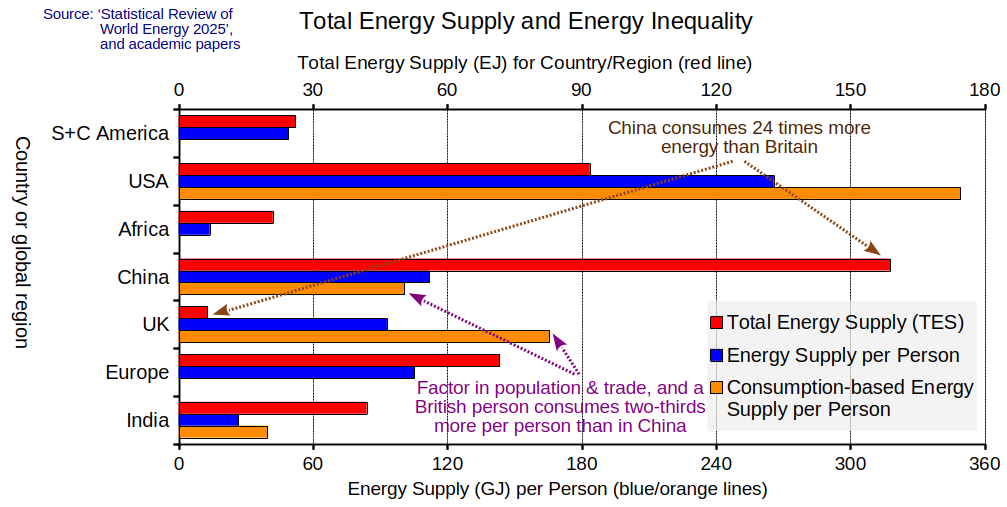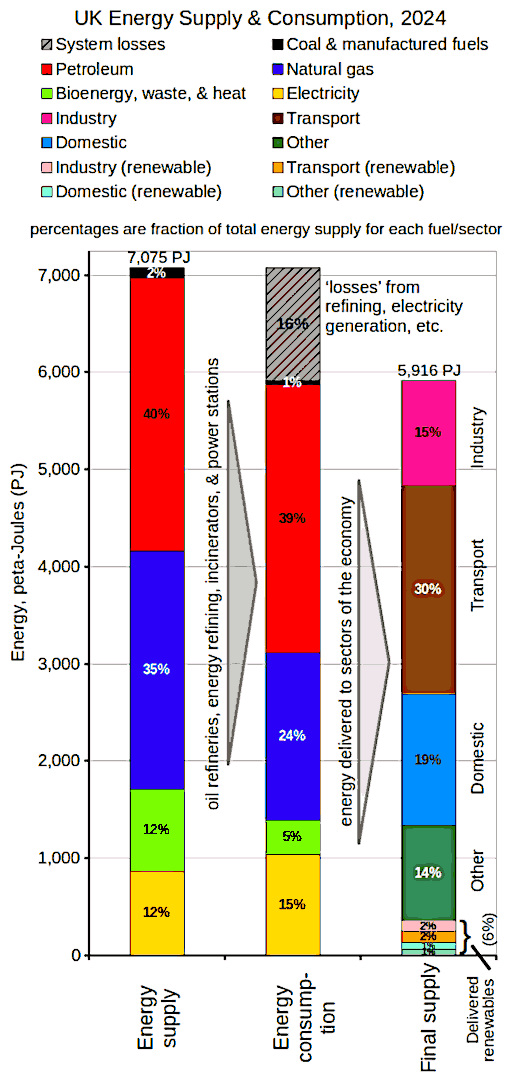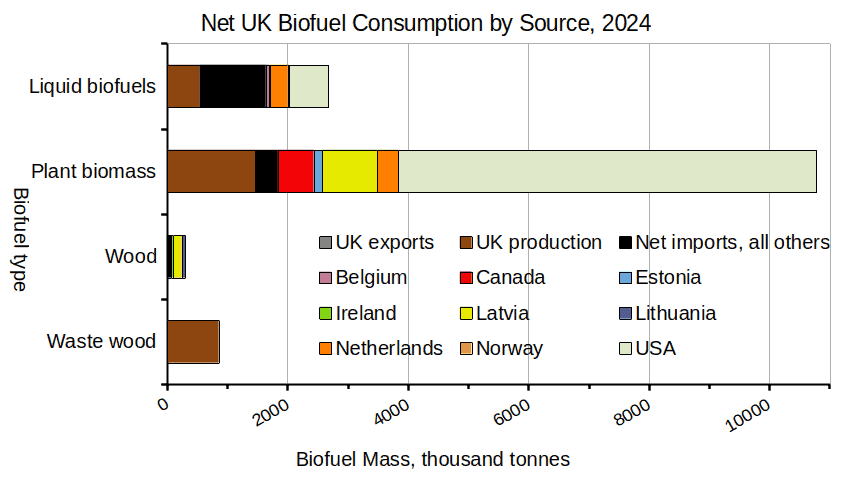
Britain’s Politicians, Media, and ‘Green’ Advocates Can’t Discuss Energy Statistics Objectively
Allegedly, ‘what gets measured gets managed’. In Britain agencies produce statistics about energy and the environment, but the substance of those statistics are largely ignored when that conflicts with the Neoliberal ideology that dominates public life today.

Energy consumption describes how we live; and when looking at the detail of how energy used it always gives ‘political’ conclusions.
For many years politicians, their media acolytes, and the pressure groups trying to influence them, have cited energy statistics in their work, but not in their totality: They consistently present a narrow, overly simplified view of the data to avoid ‘difficult’ issues.
This post explores these issues from three perspectives: How we portray our energy use in terms of its global footprint; how we actually source and use energy in the UK; and how allegedly ‘green energy’ in fact hides a destructive truth due to the scale of our energy use overall.
Misrepresenting our global energy footprint
How often have you heard a politician or pundit argue that, “it doesn’t matter what Britain does because we only use a fraction of the energy China uses”.
This is objectively true. It’s also a racist and neocolonial use of those statistics to avoid one of the most pressing issues today – ‘environmental justice’.

The graph above compares energy use in different countries. The red line/top scale show ‘total energy supply’. Yes, China uses 24 times the amount of energy of Britain. What this argument fails to take into account is that China has a population of 1,419 million, while Britain’s is 69 million – almost 21 times less.
Corrected for population, Britain uses roughly the same ‘energy per person’ as China. Per person, then what we do here has the same effect as China.
For fifty years British industries have closed and manufacturing has moved to China: Now China expends energy on our behalf; then we buy the cheap goods back from them rather than making them ourselves. This outsourced energy is called ‘consumption’ or ‘embodied energy’. At lease one-quarter of the world’s energy and carbon emissions are ‘embedded’ in world trade.
Add the value of ‘consumption energy’ from places like China, and a British person uses around two-thirds more energy than a Chinese person.
Whenever this argument about British versus Chinese energy use is made we should condemn it as racist: It argues an ‘untruth’ about another country in order to deflect from our own excess consumption; normalizes the lower consumption – and thus worse lifestyle – of the citizens of ‘foreign’ countries; and more importantly, it argues that this situation should not change.
Where does our energy come from, and where is it used?
Let’s take a subject a little closer to home – British energy use, and where our energy supply actually comes from.
For many years the basic argument underlying energy policy has been, “renewable good, fossil fuels bad”. Again, this simplistic argument is not wrong; but when looking at the data it’s far more complicated than the technological fairy-stories so often related to the public.

The graph on the right describes where our energy supply came from in 2024: The left column, ‘energy supply’, shows the raw energy value of the fuels used within Britain: 77% were fossil fuels, with the rest either ‘bioenergy and waste’ (12%) or ‘electricity’ generated from nuclear or renewable sources.
Those raw fuels get ‘transformed’ by the economy. This inevitably gives rise to ‘losses’ – the energy that gets lost from generating plants, the gas which leaks from pipes, or the heat lost supplying electricity.
Currently we ‘lose’ almost the same amount of energy from the economy as is consumed by all the households in the country.
The remaining energy sources are then ‘consumed’ by sectors of the economy: Industry, transport, domestic, and ‘other’. Yet, when we total-up the ‘delivered renewables’ part of this it comes to about 6%.
The media and politicians talk of getting “40% of our energy from renewables”. This is not true. Why?
We might get 40% of our ‘electricity’ from what is called ‘renewable sources’ – only about a third of which are the ‘green’ wind, hydro, or solar so often talked about; but as electricity is only 15% of ‘energy consumption’, 40% of 15% equals, 6%.

Politicians, the media, and many ‘green’ groups, are misleading the debate as they focus on electricity – giving the idea that most of what we use is electricity when it’s only about a sixth. What’s worse, what we call ‘renewable’ is coming more from ‘waste’, and especially ‘biofuels’ (see below) – the impact of which is not much better, and sometimes worse than fossil fuels.
The debate over energy in Britain misdirects people’s attention from the basic truth: We consume too much energy. Only ‘degrowth’ can actually shrink fossil fuel use; but this option is not allowed to be debated because it violates the basis of the Neoliberal ideology governing our society.
Britain is deforesting the world for ‘biofuels’
A key part of successive British government energy strategies has been to import large quantities of biofuels from across the globe.
Biofuels are produced from the land, which is why they are considered, ‘renewable’. Britain not only has one of the lowest levels of forest cover in Europe, much of the land suitable for energy crops is already under cultivation for food: We don’t have the space to grow & harvest large amounts of biofuels.
Biofuels give the appearance that we are increasing ‘green’ energy use when, in fact, we are pushing deforestation, and supporting prairie monocultures for the production of ethanol or biodiesel (for a detailed review of this see the website of the group, BiofuelWatch).

The graph above shows where Britain sourced its biofuels in 2024. Except for wood waste – where we produce an excess to export – most of Britain’s biofuel’s are imported to meet our large demand.
‘Plant biomass’ is largely ground-up trees and woody material, squeezed into pellets – to avoid the problems that are created when wood chips are stored.
Most of these imported wood pellets are burned at one site – Drax power station in Yorkshire, with trains ferrying over two-thousand tonnes at a time from Liverpool Docks to the plant.
There is also a growing market for wood pellets amongst households, companies, and public buildings who want to go ‘carbon neutral’ – burning the pellets in the belief that they do not lead to excessive carbon emissions: In fact scientific literature tells a very different story.
‘Liquid biofuels’, like biodiesel or the ethanol added petrol, are called ‘green’ as they use crops or waste materials rather than fossil fuels (again, the academic research on this is debatable). Yet how we actually import biofuels contradicts basic ecological principles:
In 2024 Britain imported 595,248 tonnes of biodiesel from The Netherlands; in 2024 we exported 306,993 to The Netherlands. It would have been ‘greener’ if we kept our biodiesel and The Netherlands had sent 288,255 tonnes – the outcome would have been no different, except for a reduction in various types of pollution.
The reason we engage in this polluting and wasteful ‘reciprocal trade’ – in all forms of energy, biofuels, and other goods – is that it makes more money for the middlemen of the trade system. This is exactly what Britain’s ‘green’ energy sector is designed to do! It’s known as ‘arbitrage’ – brokering resources backwards and forwards to get a better price or take advantage of trade subsidies or tariffs.
If we wanted to ‘green’ Britain we would massively reduce car use, avoiding the need for fuel; and we would create better housing to avoid the need for heat and power. These options are not on the table, though, because they reduce consumption; and by reducing consumption it appears to reduce the ‘economic activity’ (like reciprocal trade) which all politicians believe makes life better.
Our ‘green energy’ system, like the rest of the economy, is a Neoliberal fraud: It is physically incapable of stopping environmental damage because it is incapable of taking the actions that would achieve this.